Charles E W Bean, Diaries, AWM38 3DRL 606/277/1 - 1926-1939 - Part 1
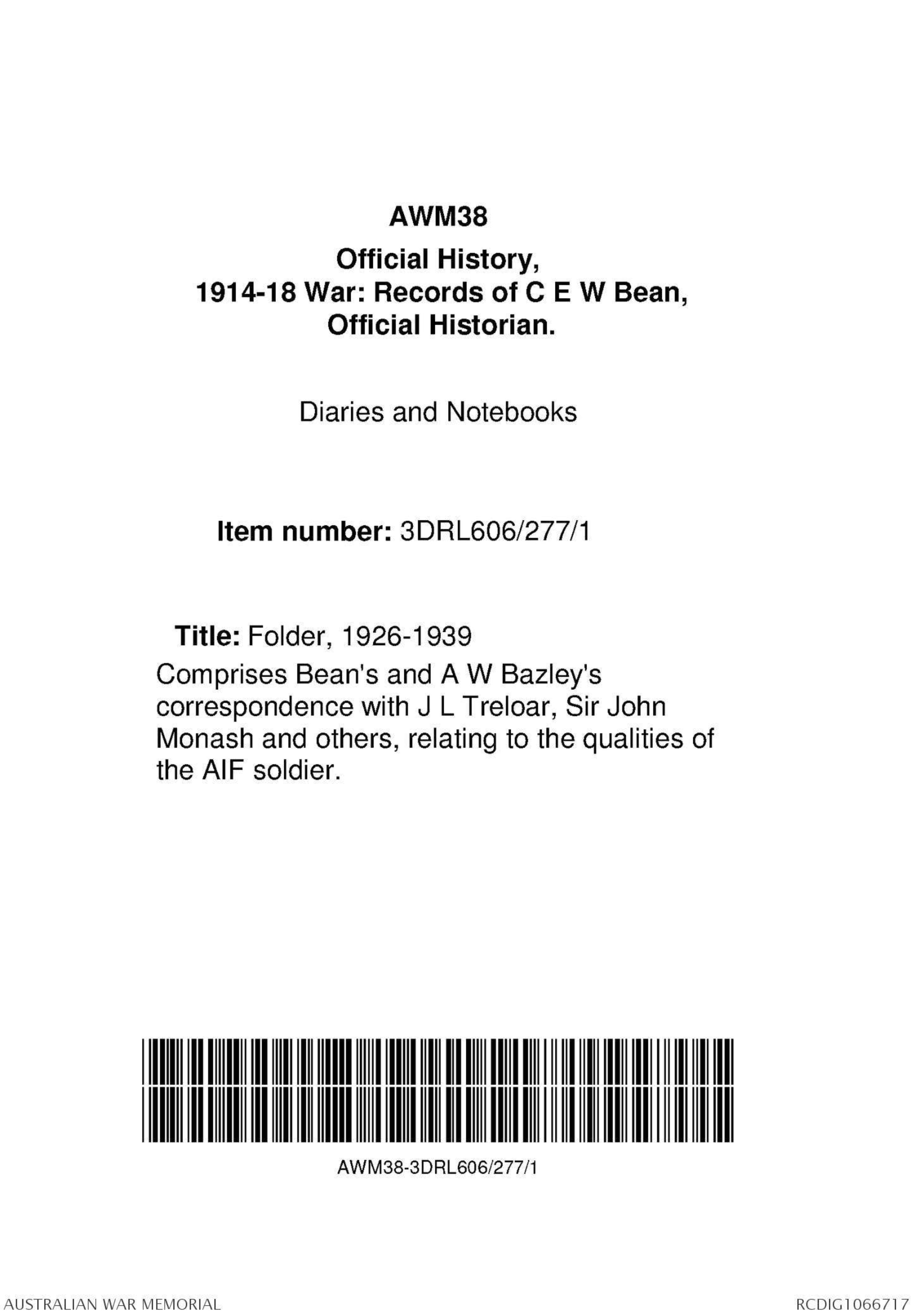
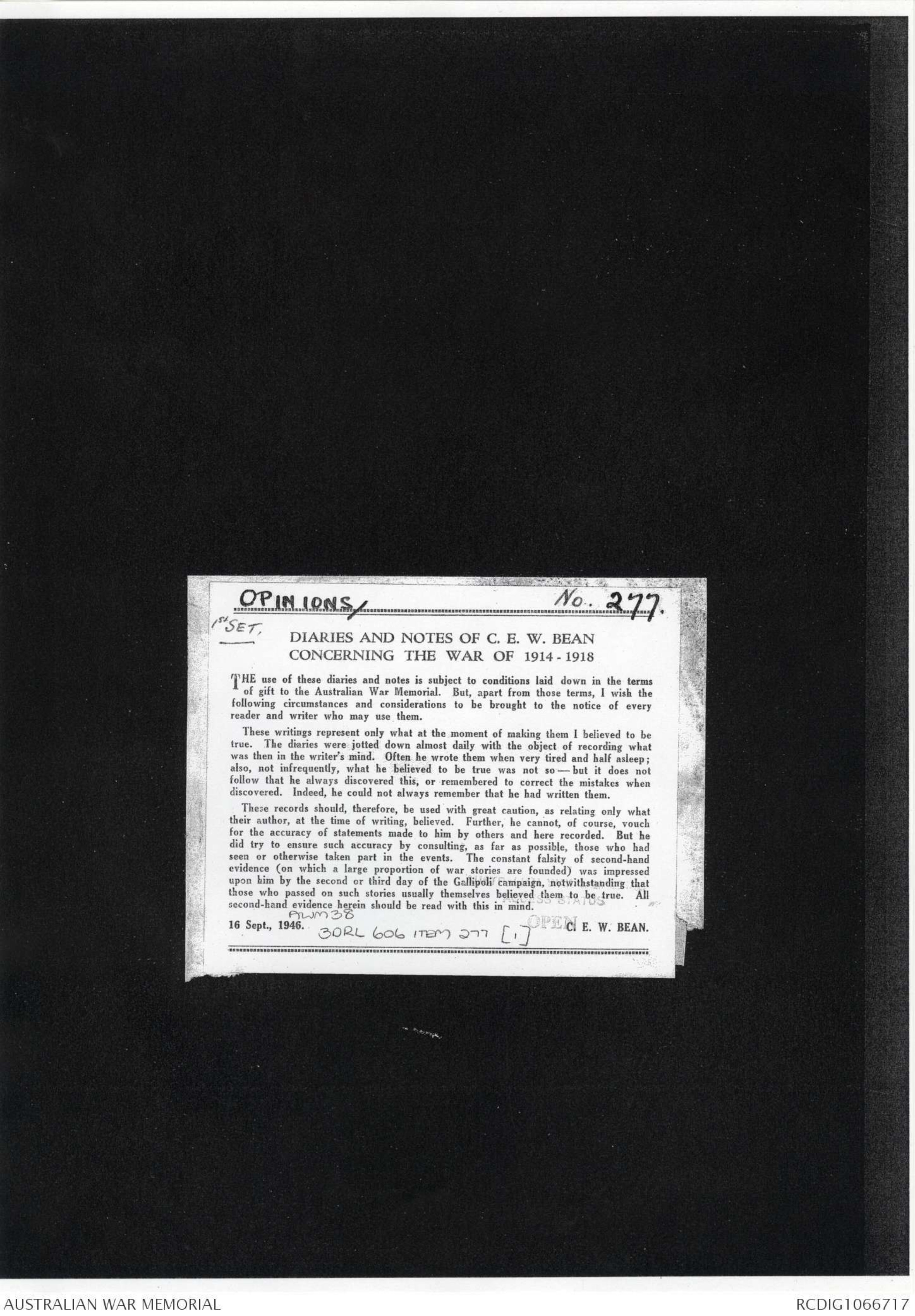
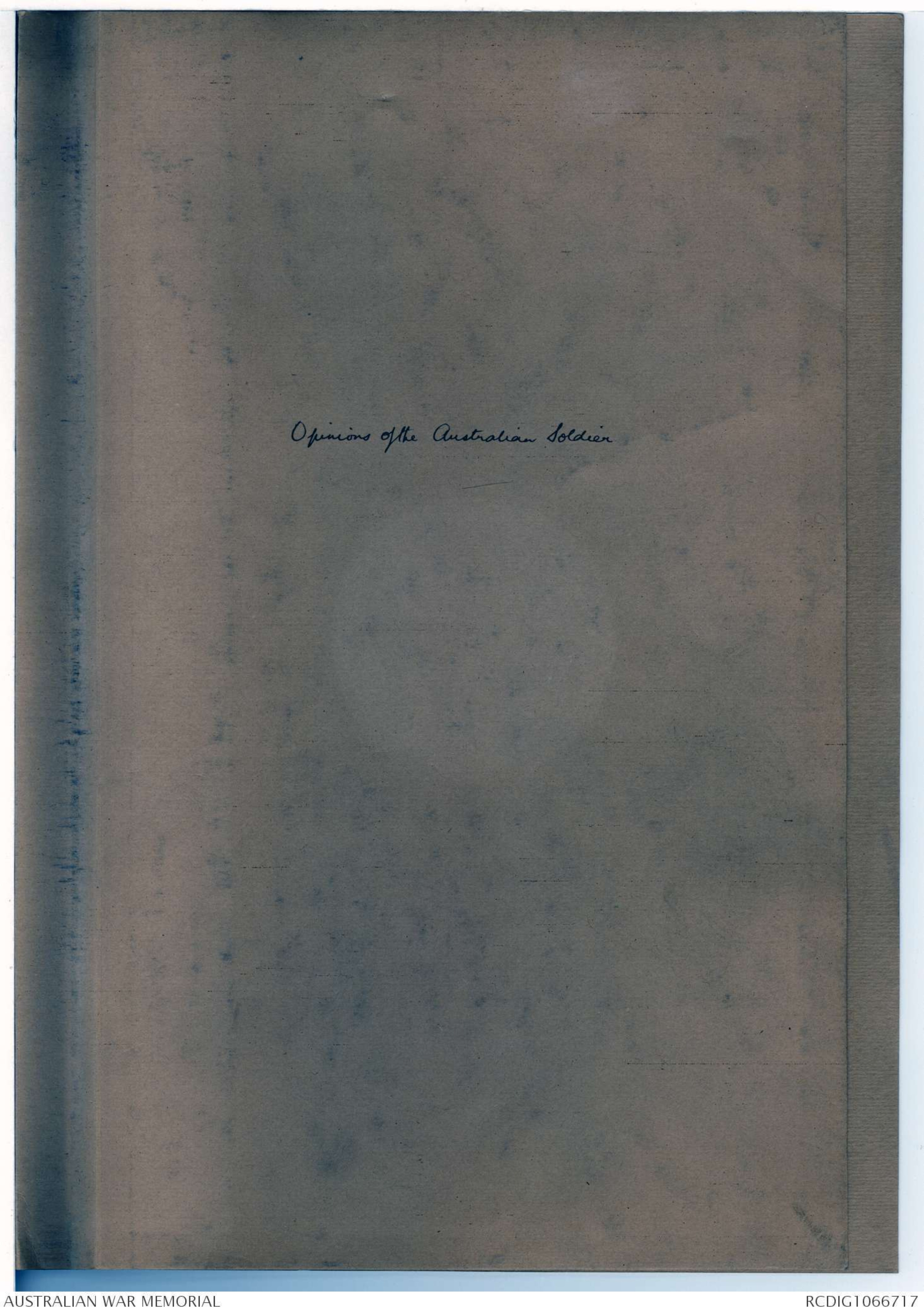
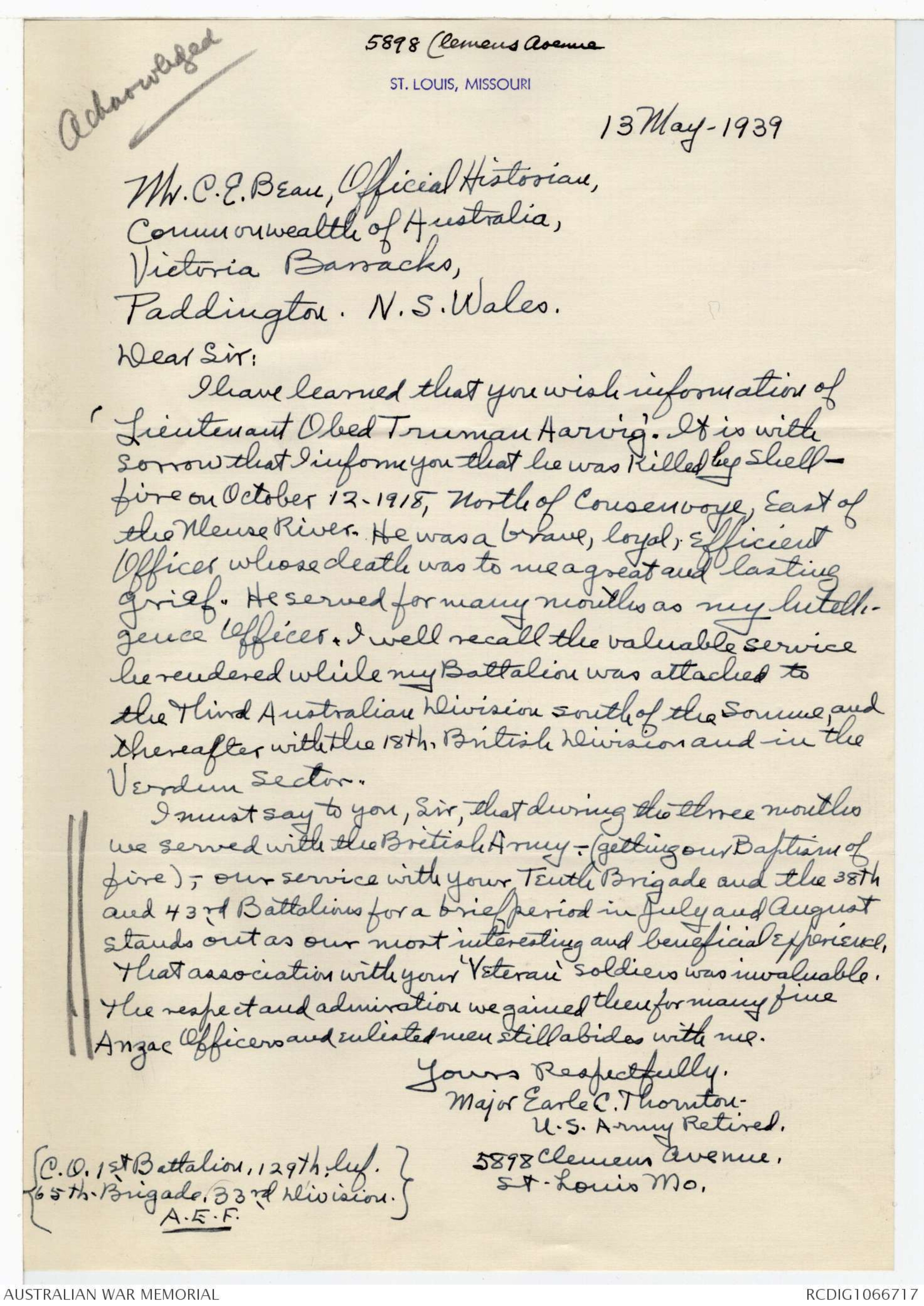

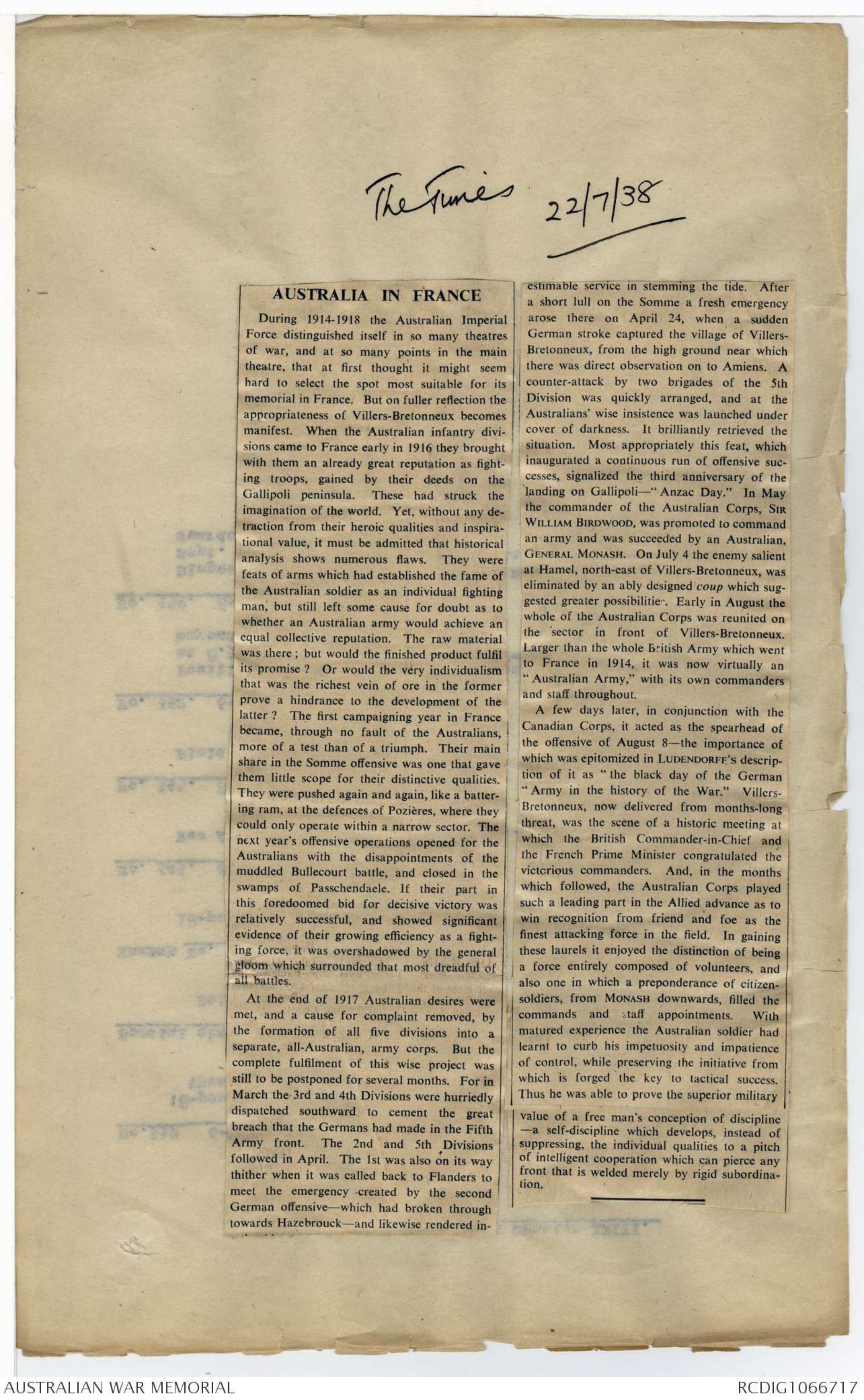
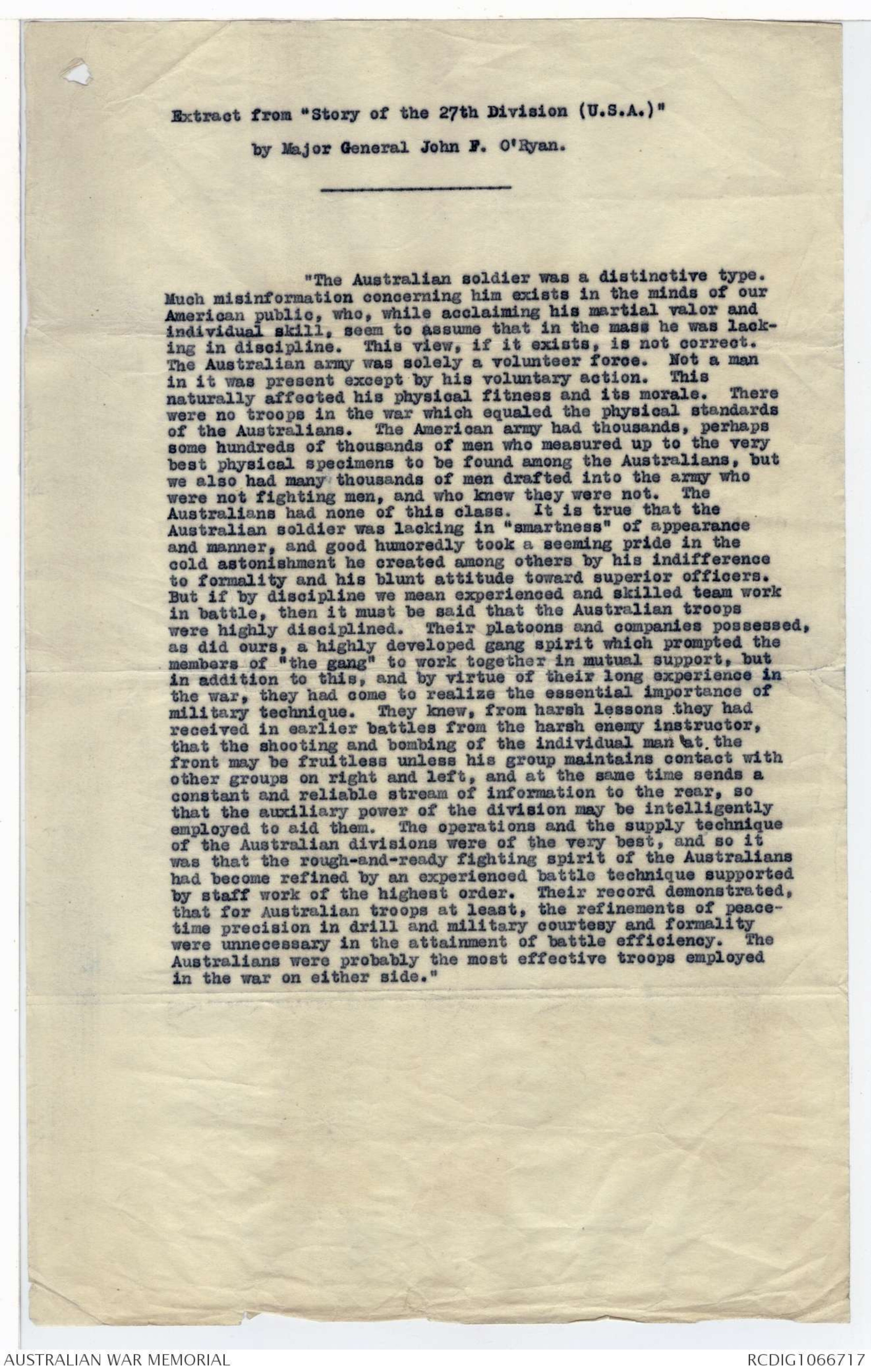
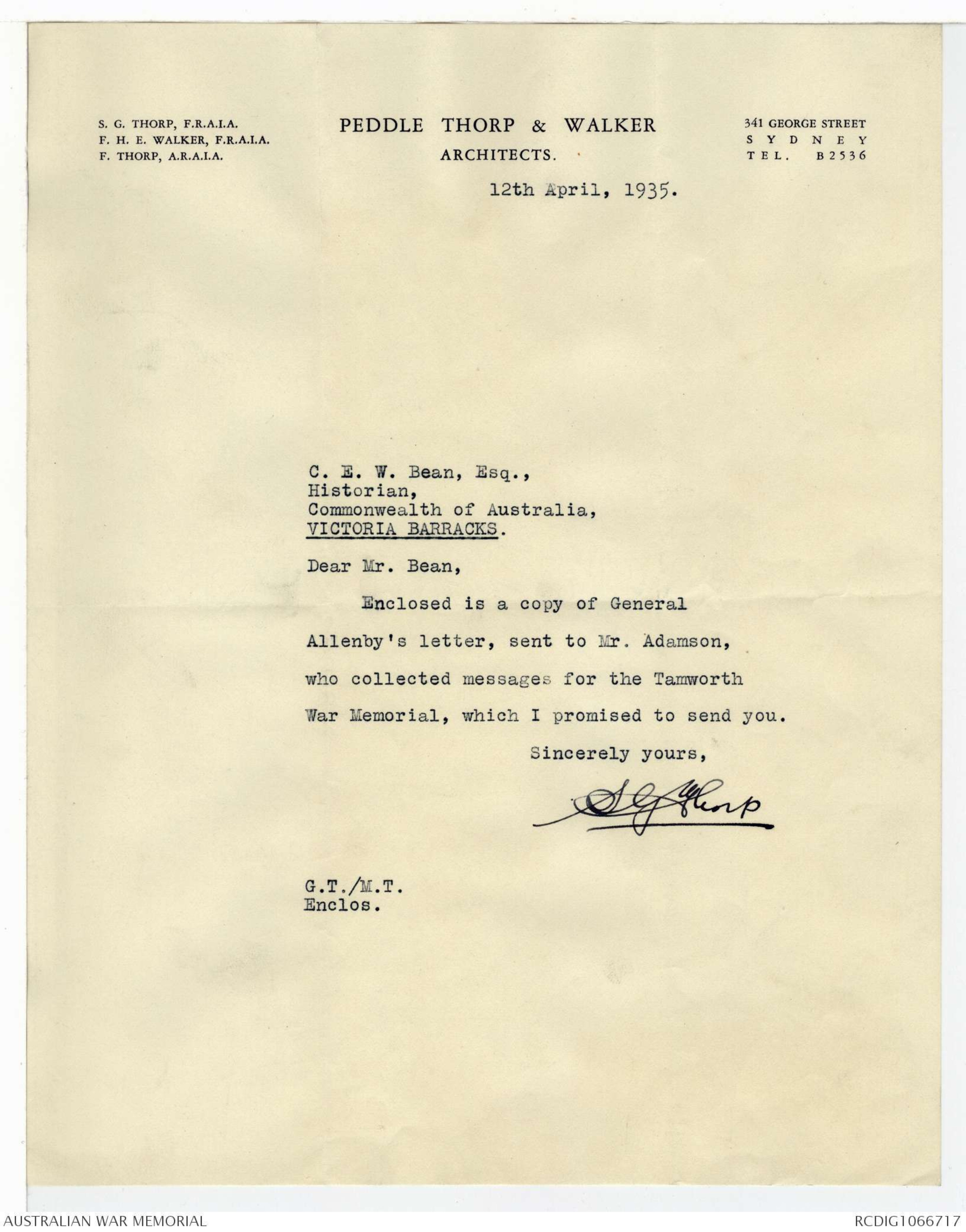
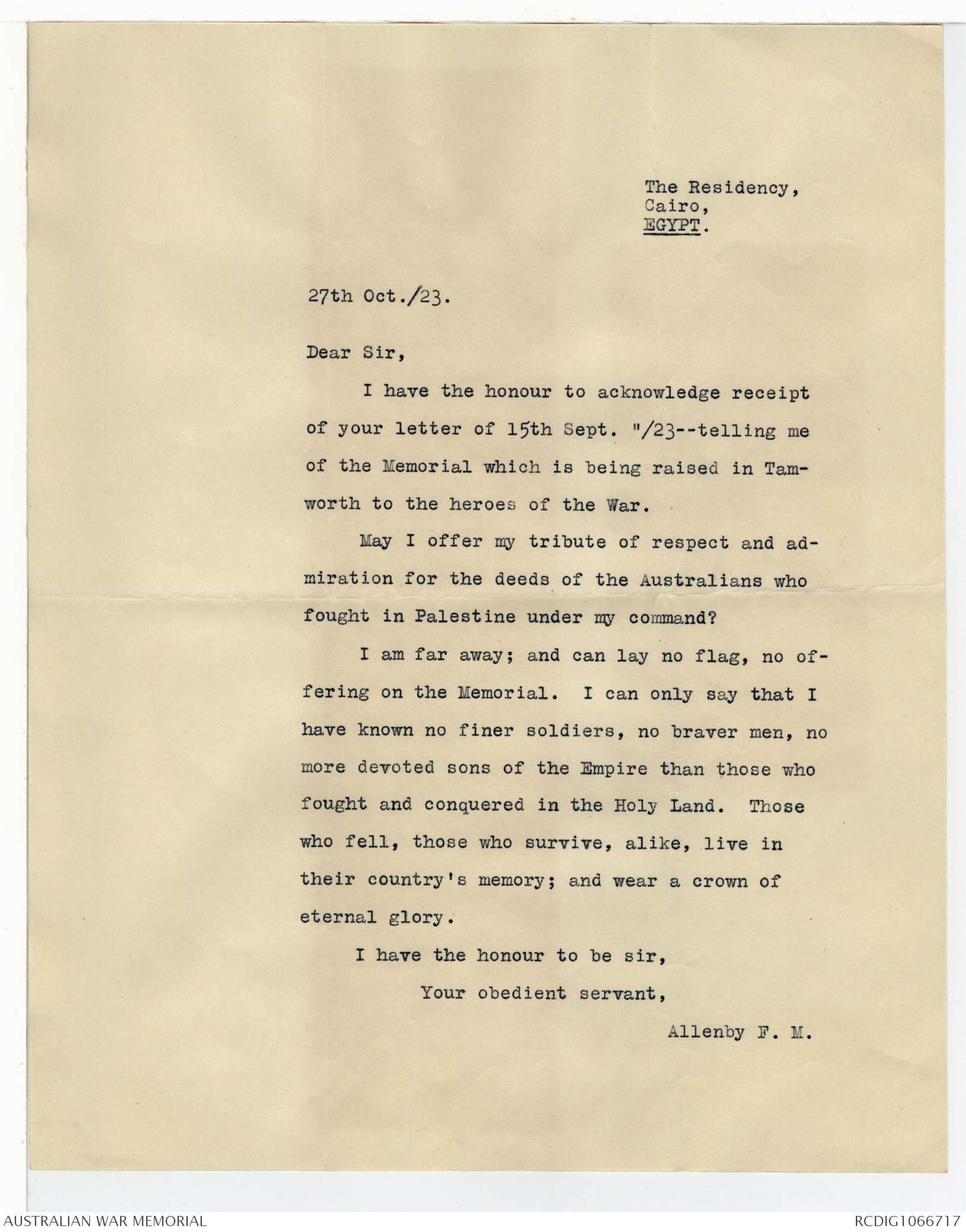
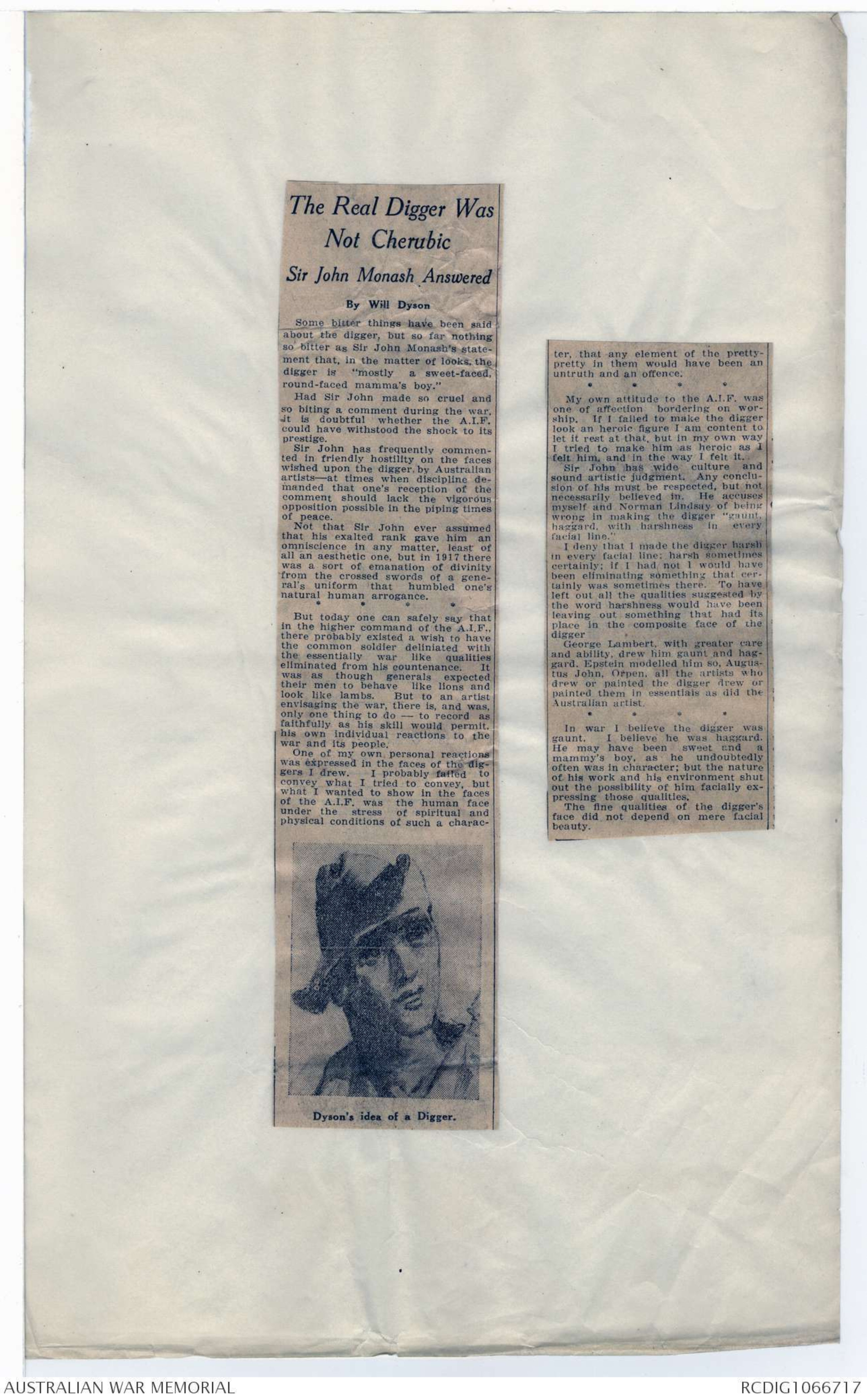
AWM38
Official History,
1914-18 War: Records of C E W Bean,
Official Historian.
Diaries and Notebooks
Item number: 3DRL606/277/1
Title: Folder, 1926-1939
Comprises Bean's and A W Bazley's
correspondence with J L Treloar, Sir John
Monash and other, relating to the qualities of
the AIF soldier.
AWM38-3DRL606/227/1
OPINIONS
No. 277
1st SET
DIARIES AND NOTES OF C. E. W. BEAN
CONCERNING THE WAR OF 1914 - 1918
The use of these diaries and notes is subject to conditions laid down in the terms
of gift to the Australia War Memorial. But, apart from those terms, I wish the
following circumstances and considerations to be brought to the notice of every
reader and writer who may use them.
These writing represent only what at the moment of making them I believed to be true. The diaries were jotted down almost daily with the object of recording what
was then in the writer's mind. Often he wrote them when very tired and half asleep ;
also, not infrequently, what he believed to be true was not so - but it does not
follow that he always discovered this or remembered to correct the mistakes when
discovered. Indeed, he could not always remember that he had written them.
These records should, therefore, be used with great caution, as relating only what
their author, at the time of writing, believed. Further, he cannot, of course, vouch
for the accuracy of statements made to him by others and here recorded. But he
did try to ensure such accuracy by consulting, as far as possible, those who had
seen or otherwise taken part in the events. The constant falsity of second-hand
evidence (on which a large proportion of war stories are founded) was impressed
upon him by the second or third day of the Gallipoli campaign, notwithstanding that
those who passed on such stories usually themselves believed them to be true. All
second-hand evidence herein should be read with this in mind.
16 Sept., 1946 AWM38 3DRL606 ITEM277 [1] OPEN C.E.W. BEAN
Opinions of the Australian Soldier
Acknowledged
5898 Clemens Avenue
St. Louis, Missouri
13 May-1939
Mr. C.E. Bean, Official Historian,
Commonwealth of Australia,
Victoria Barracks,
Paddington. N.S.Wales.
Dear Sir,
I have learned that you wish information of
Lieutenant Obed Truman Harvig. It is with
sorrow that I inform you that he was killed by shell-
fire on October 12, 1918, north of Cousenvoye, East of
the Meuse River. He was a brave, loyal, efficient
Officer whose death was to me a great and lasting
grief. He served for many months as my Intelligence
Officer. I will recall the valuable service
he rendered while by Battalion was attached to
the Third Australian Division south of the Somme, and
thereafter with the 18th. British Division and in the
Verdun Sector.
I must say to you, Sir, that during the three months
we served with the British Army - (getting our Baptism of
fire),-our service with your Tenth Brigade and the 38th
and 43rd Battalions for a brief period in July and August
stands out as our most interesting and beneficial experience.
That association with your 'Veteran' soldiers was invaluable.
The respect and admiration we gained there for many fine
Anzac Officers and enlisted men still abides with me.
Yours Respectfully
Major Earle C. Thornton -
U.S. Army Retired.
5898 Clemens Avenue,
St. Louis Mo.
(C.O. 1st Battalion, 129th Inf.
65th Brigade, 33rd Division.
A.E.F)
Reveille
Oct 1931
War's' Best: Aussie Soldiers
"The Australian were the most effective fighting soldiers
on either side in the war," was the glowing praise
of Major-General John O'Ryan, the Commander of the
27th (American) Division, in a recent speech in New
York.
"Throughout all their suffering and hardship and sacrifice the attitude
of the Australians was marked by a grim humour. When they
died, they died quietly and without kicking up a fuss. There were
a number of Australians who lost their lives in attempts to give aid
to men of our division who had been knocked out in raids. There are
a number of my men who are buried in France who gave up their lives
in similar efforts on behalf of Australian soldiers; and so, built upon
that type of relation and comradeship, you can well imagine what
a high regard we hold for our Australian cousins and comrades."
The Times
22/7/38
AUSTRALIA IN FRANCE
During 1914-1918 the Australian Imperial
Force distinguished itself in so many theatres
of war, and at so many points in the main
theatre, that at first thought it might seem
hard to select the spot most suitable for its
memorial in France. But on fuller reflection the
appropriateness of Villers-Bretonneux becomes
manifest. When the Australian infantry divisions
came to France early in 1916 they brought
with them an already great reputation as fighting
troops, gained by their deeds on the
Gallipoli peninsula. These had struck the
imagination of the world. Yet, without any detraction
from their heroic qualities and inspirational
value, it must be admitted that historical
analysis shows numerous flaws. They were
feats of arms which had established the fame of
the Australian soldier as an individual fighting
man, but still left some cause for doubt as to
whether an Australian army would achieve an
equal collective reputation. The raw material
was there; but would the finished product fulfil
its promise? Or would the very individualism
that was the richest vein of ore in the former
prove a hindrance to the development of the
latter? The first campaigning year in France
became, through no fault of the Australians,
more of a test than of a triumph. Their main
share in the Somme offensive was one that gave
them little scope for their distinctive qualities.
They were pushed again and again, like a battering
ram, at the defences of Poziěres, where they
could only operate within a narrow sector. The
next year's offensive operations opened for the
Australians with the disappointments of the
muddles Bullecourt battle, and closed in the
swamps of Passchendaele. If their part in
this foredoomed bid for decisive victory was
relatively successful, and shows significant
evidence of their growing efficiency as a fighting
force, it was overshadowed by the general
gloom which surrounded that most dreadful of
all battles.
At the end of 1917 Australian desires were
met, and a cause for complaint removed, by
the formation of all five division into a
separate, all-Australia, army corps. But the
complete fulfilment of this wise project was
still to be postponed for several months. For in
March the 3rd and 4th Divisions were hurriedly
dispatched southward to cement the great
breach that the Germans had made in the Fifth
Army front. The 2nd and 5th Divisions
followed in April. The 1st was also on its way
thither when it was called back to Flanders to
meet the emergency created by the second
German offensive - which had broken through
towards Hazebrouck - and likewise rendered inestimable
service in stemming the tide. After
a short lull on the Somme a fresh emergency
arose there on April 24, when a sudden
German stroke captured the village of Villers-
Bretonneux, from the high ground near which
there was direct observation on to Amiens. A
counter-attack by two brigades of the 5th
Division was quickly arranged, and at the
Australian's wise insistence was launched under
cover of darkness. It brilliantly retrieved the
situation. Most appropriately this feat, which
inaugurated a continuous run of offensive successes,
signalized the third anniversary of the
landing on Gallipoli - "Anzac Day." In may
the commander of the Australian Corps. SIR
WILLIAM BIRDWOOD, was promoted to command
an army and was succeeded by an Australian,
GENERAL MONASH. On July 4 the enemy salient
at Hamel, north-east of Villers-Bretonneux, was
eliminated by an ably designed coup which suggested
greater possibilities. Early in August the
whole of the Australia Corps was reunited on
the sector in front of Villers-Bretonneux.
Larger than the whole British Army which went
to France in 1914, it is now virtually an
"Australian Army," with its own commanders
and staff throughout.
A few days later, in conjunction with the
Canadian Corps, it acted as the spearhead of
the offensive of August 8 - the importance of
which was epitomized in LUDENDORFF'S description
of it as "the black day of the German
Army in the history of the War." Villers-
Bretonneux, now delivered from months-long
threat, was the scene of a historic meeting at
which the British Commander-in-Chief and
the French Prime Minister congratulated the
victorious commanders. And, in the months
which followed, the Australian Corps played
such a leading part in the Allied advance as to
win recognition from friend and foe as the
finest attacking force in the field. In gaining
these laurels it enjoyed the distinction of being
a force entirely composed of volunteers, and
also one in which a preponderance of citizen-
soldiers, from MONASH downwards, filled the
commands and staff appointments. With
matured experience the Australian soldier had
learnt to curb his impetuosity and impatience
of control, while preserving the initiative from
which is forged the key to tactical success.
Thus he was able to prove the superior military
value of a free man's conception of discipline
-a self-discipline which develops, instead of
suppressing, the individual qualities to a pitch of
intelligent cooperation which can pierce any
front that is welded merely by rigid subordination.
Extract from "Story of the 27th Division (U.S.A.)"
by Major General John F. O'Ryan.
---------------------------------------------
"The Australian soldier was a distinctive type.
Much misinformation concerning him exists in the minds of our
American public , who, while acclaiming his martial valor and
individual skill, seem to assume that in the mass he was lacking
in discipline. This view, if it exists, in not correct.
The Australian army was solely a volunteer force. Not a man
in it was present except by his voluntary action. This
naturally affected his physical fitness and its morale. There
were not troops in the war which equaled the physical standards
of the Australians. The American army had thousands, perhaps
some hundreds of thousands of men who measured up to the very
best physical specimens to be found among the Australians, but
we also had many thousands of men drafted into the army who
were not fighting men, and who knew they were not The
Australians had none of this class. It is true that the
Australian soldier was lacking in "smartness" of appearance
and manner, and good humoredly took a seeming pride in the
cold astonishment he created among others by his indifference
to formality and his blunt attitude toward superior officers.
But if by discipline we mean experienced and skilled teem work
in battle, then it must be said that the Australian troops
were highly disciplined. Their platoons and companies possessed,
as did ours, a highly developed gang spirit which prompted the
members of "the gang" to work together in mutual support, but
in addition to this and by virtue of their long experience in
the war, they had come to realize the essential importance of
military technique. They knew, from harsh lessons they had
received in earlier battles from the harsh enemy instructor,
that the shooting and bombing of the individual man at the
front may be fruitless unless his group maintains contact with
other groups on right and left and at the same time sends a
constant and reliable stream of information to the rear, so
that the auxiliary power of the division may be intelligently
employed to aid them. The operations and the supply technique
of the Australian divisions were of the very best, and so if
was that the rough-an-ready fighting spirit of the Australians
had become refined by an experience battle technique supported
by staff work of the highest order. Their records demonstrated
that for Australian troops at leas, the refinements of peace-time
precision in drill and military courtesy and formality
were unnecessary int eh attainment of battle efficiency the
Australians were probably the most effective troops employed
in the war on either side."
S.G.THORP, F.R.A.I.A.
F.H.E. WALKER, F.R.A.I.A
F. THORP, A.R.A.I.A.
PEDDLE THORP & WALKER
ARCHITECTS
341 GEORGE STREET
SYDNEY
TEL. B2536
12th April, 1935.
C.E.W. Bean, Esq.,
Historian,
Commonwealth of Australia,
VICTORIA BARRACKS.
Dear Mr. Bean,
Enclosed is a copy of General
Allenby's letter, send to Mr. Adamson.
who collected messages for the Tamworth
War Memorial, which I promised to send you.
Sincerely yours,
S G Thorp
G.T./M.T.
Enclos.
The Residency,
Cairo,
EGYPT.
27th Oct./23.
Dear Sir,
I have the honour to acknowledge receipt
of your letter of 15th Sept. "/23--telling me
of the Memorial which is being raised in Tamworth
to the heroes of the War.
May I offer my tribute of respect and admiration
for the deeds of the Australians who
fought in Palestine under my command?
I am far away; and can lay no flag, no offering
on the Memorial. I can only say that I
have known no finer soldiers, no braver men, no
more devoted sons of the Empire that those who
fought and conquered in the Holy Land. Those
who fell, those who survive, alike, live in
their country's memory; and wear a crown of
eternal glory.
I have the honour be sir,
Your obedient servant,
Allenby F.M.
The Real Digger Was Not Cherubic
Sir John Monash Answered
by Will Dyson
Some bitter things have been said
about the digger, but so far nothing
so bitter as Sir John Monash's statement
that, in the matter of looks, the
digger is "mostly a sweet-faced
round-faced mamma's boy."
Had Sit John made so cruel and
so biting a comment during the war,
it is doubtful whether the A.I.F
could have withstood the shock to its
prestige.
Sir John has frequently commented
in friendly hostility on the faces'
wished upon the differ, by Australian
artists - at times when discipline demanded
that one's reception of the
comment should lack the vigorous
opposition possible in the piping times
of peace.
Not that Sir John ever assumed
that his exalted rank gave him an
omniscience in any matter, least of
all an aesthetic one, but in 1917 there
was a sort of emanation of divinity
from the crossed swords of a general's
uniform that humbled one's
natural human arrogance.
* * * *
But today one can safely say that
in the higher commands of the A.I.F.,
there probably existed a wish to have
the common soldier deliniated with
the essentially war like qualities
eliminated from his countenance. It
was as though generals expected
their men to behave like lions and
look like lambs. But to an artist
envisaging the war, there is, and was,
only one thing to do - to record as
faithfully as his skill would permit,
his own individual reactions to the
war and its people.
One of my own personal reactions
was expressed in the faces of the diggers
I drew. I probably failed to
convey what I tried to convey, but
what I wanted to show in the faces
of the A.I.F. was the human face
under the stress of spiritual and
physical conditions of such a character,
Drawing - see original article
Dyson's idea of a Digger
that any element of the pretty-
pretty in them would have been an
untruth and an offence.
****
My own attitude to the A.I.F. was
one of affection bordering on worship.
If I failed to make the digger
look an heroic figure I am content to
let it rest at that, but in my own way
I tried to make his as heroic as
I felt him, and in the way I felt it.
Sir John had wide culture and
sound artistic judgment. Any conclusion
of his must be respected, but not
necessarily believed in. He accuses
myself and Norman Lindsay of being
wrong in making the digger "gaunt,
haggard, with harshness in every
facial line."
I deny that I made the digger harsh
in every facial line; harsh sometimes
certainly; if I had not I would have
been eliminating something that certainly
was sometimes there. To have
left out all the qualities suggested by
the word harshness would have been
leaving out something that had its
place in the composite face of the digger.
George Lambert, with greater are
and ability, drew him gaunt and haggard.
Epstein modelled him so, Augustus
John Orpen, all the artists who
drew or painted the digger drew or
painted in essentials as did the
Australia artist.
****
In war I believe the digger was
gaunt. I believe he was haggard.
He may have been sweet and a
mammy's boy, as he undoubtedly
often was in character; but the nature
of his work and his environment shut
out the possibility of him facially expressing
those qualities.
The fine qualities of the digger's
face did not depend on mere facial
beauty.
 Sam scott
Sam scottThis transcription item is now locked to you for editing. To release the lock either Save your changes or Cancel.
This lock will be automatically released after 60 minutes of inactivity.